- Performing Post-Installation Operations
- Configuring Advanced Settings
- Configuring Alerts
- Configuring the Discovery Overrides
- Configuring Logs
- Filtering Elements to Monitor
- Configuring the Jobs Monitoring
- Configuring the Policy Backup Restriction Window
- Configuring the Mount Requests Monitoring
- Configuring the Mount Requests Date/Time Format
- Configuring the Multi-Node Monitoring Mode
- Configuring the Node Status
- Configuring the Node Type
-
Home
- PATROL
Configure Veritas NetBackup KM
This section explains the settings required to configure Veritas NetBackup KM via a PATROL console.
Performing Post-Installation Operations
It is recommended to perform post installation checks once the KM is installed and loaded on the PATROL Console to ensure it properly operates. Post-installation operations include:
- Configuring NetBackup Nodes Monitoring
- Configuring the KM user account
- Verifying:
- Restarting the PATROL Agent and PATROL Console.
Configuring NetBackup Nodes Monitoring
Veritas NetBackup KM allows you to monitor several NetBackup master and media servers, and NetBackup appliances with one PATROL Agent. The configuration procedure is as follows:
-
Right-click the Veritas NetBackup main instance > Configuration > NetBackup Nodes…
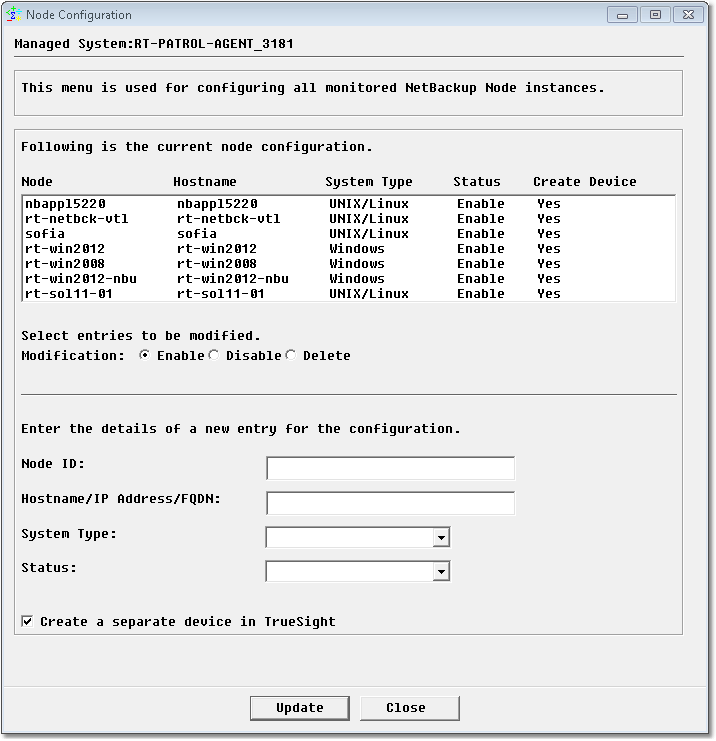
-
Specify the NetBackup server details:
- Node ID: Enter an ID for the NetBackup node. This information is only required if a unique ID cannot be generated using the hostname provided.
- (Required) Hostname/IP Address/FQDN: Enter the hostname, IP address, or FQDN of the node to be monitored.
- (Required) System Type: Specify whether the NetBackup node is a UNIX/Linux or Windows system.
- (Required) Status: Select Enable to start the NetBackup node monitoring; Disable to stop it.
-
Check the Create a separate device in TrueSight box if you want the NetBackup nodes to appear as a separate device in TrueSight OM.
-
Click Update.
A NetBackup Setup node instance (NetBackup Setup: <node-id>) appears in the PATROL Console but the monitoring will not start until the appropriate credentials are entered using the Configuration > Login KM Command.
Configuring the KM User Account
A user account with administrative privileges must be configured in BMC PATROL or BMC TrueSight Operations Management to read and execute Veritas NetBackup application programs and access file systems. Depending on the operating systems used, several options will be available. For more information, refer to Security Requirements.
To configure the KM user account:
-
In the Console, right-click the host instance > KM Commands > Configuration > Login… The Login Configuration dialog box is displayed:
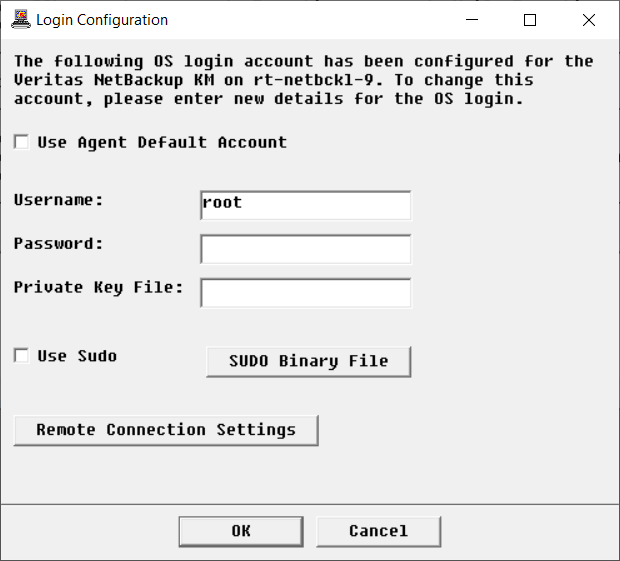
-
To use:
- the default PATROL Agent Account, check the Use Agent Default Account box and leave the Username, Password and Private Key File fields empty
- a different user account, enter the login details in the Username, Password and optional Private Key File fields. For SSH authentication, you can specify the path to a private key file on the PATROL Agent corresponding to the specified username and password.
-
If a sudo user account is used:
- check the Use Sudo box
- click SUDO Binary File to verify the sudo binary file path
-
If you are monitoring a remote host, click Remote Connection Settings:
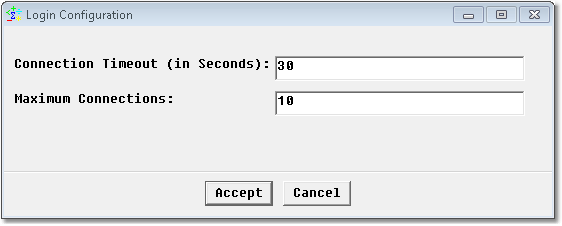
- Connection Timeout (in Seconds): Enter the number of seconds after which the connection to the remote node will timeout.
- Maximum Connections: Enter the maximum number of simultaneous connections allowed to the remote node.
- Click Accept.
-
Click OK.
If the credentials are not valid, the NBULoginStatus parameter will appear in “suspicious state” after the next data collection.
Verifying the Application Discovery
To verify the application discovery:
-
Check that the NetBackup Setup instance changes to display the server type. If not, check the message in the NetBackup Setup instance and in the PATROL Console System Output Window (SOW) or in the log file <PATROL_HOME>/log/NBU_<port>.log. You can force a full discovery by right-clicking the NetBackup Setup instance > KM Commands > Force Discovery.
-
Check that the application class instances are actually instantiated. The initial data collection may take some time depending on the complexity of your environment (up to one hour). If needed, force a data collection by right-clicking the server instance > KM Commands > Refresh Parameters.
If Veritas NetBackup master/media server is configured in a clustered environment, you will have to enable multi-node mode monitoring.
Configuring the Instance Limits
Veritas NetBackup KM monitors all the elements discovered, except for Clients, Policy Clients, Mount Requests and Standalone Drives that are disabled by default. This may represent an important workload to the PATROL Agents and console. Because the monitoring of some elements may be irrelevant for various reasons, you can apply filters to indicate which elements will be monitored or not.
To modify the default configuration:
-
In the Console, right-click the server instance > KM Commands > Configuration > Instance Limits…
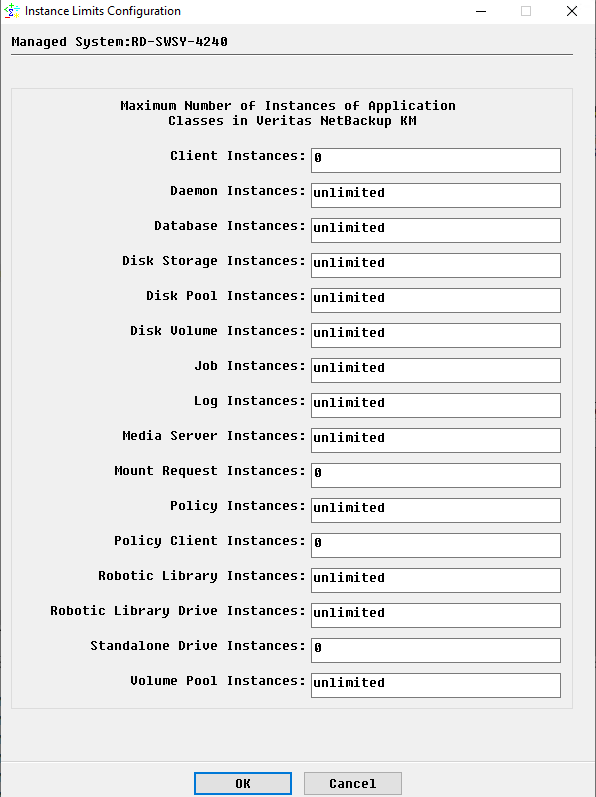
-
Enter the number of instances to be displayed in the console for each monitored element
-
To disable the monitoring of a specific application class, enter 0 (zero) in the relevant field
-
Click OK.
Verifying the Initial Setup
To check the initial setup of the KM:
-
Check for any error on the PATROL Console System Output Window (SOW) or in the
<PATROL_HOME>/log/NBU_<port>.log. -
Check whether the discovered files and directory paths are correct, using the menu Configuration > Paths… from the server instance.
-
Refer to the label of the server instance to check whether the discovered node type is correct. The node type can be modified, using the menu Configuration > Node Type… from the server instance.
-
Check the Infoboxes and Parameters of all the Veritas NetBackup KM instances and verify that they are properly set.
-
Under each container instance, open all detail parameters (text parameters with names in the format
NBU<Object>Details), and check for error messages. -
Check the new value of the NBULoginStatus and NBUNodeStatus parameters set after the completion of all data collection. If either is not in OK state, open the annotation point to determine the cause of the error. Veritas NetBackup KM will check for the existence of the following daemons to determine the status of the node (parameter NBUNodeStatus). By default, these daemons are sought:
On a Master Server:
| Daemon | Description |
|---|---|
| bpdbm | NetBackup Database Manager Daemon |
| bprd | NetBackup Request Daemon |
| vmd | Volume Manager Daemon |
On a Media Server:
| Daemon | Description |
|---|---|
| avrd | Automatic Volume Recognition Daemon |
| ltid | Media Manager Device Daemon |
| vmd | Volume Manager Daemon |
These default daemons can however be changed through the menu Configuration > Node Status…. Refer to Configuring the Node Status for more details.
-
After the KM has been running for at least an hour:
- Right-click the server instance > KM commands > KM Status… from the Veritas NetBackup instance. A report is displayed, detailing information on the managed system. Check through the report for any warning or alarm. If any error is found during any of the above steps (including any incorrect data in Infoboxes or any warning or alarm in the KM Status report), determine the cause(s) and take steps to resolve these errors. You may need to refer to the User Guide, or contact Technical Support, attaching the KM Status report.
- If needed, click Save As Task to open the report in a task window. You could later save it as a text file or print it.
-
The KM installed on the master server may monitor the same storage, disk pools, disk volumes, robotic libraries & drives which are already monitored through the media servers. This may be unnecessary and can trigger duplicate alerts. You can disable these components on either master server or media server by setting their instance limit to 0 (zero), using the menu Configuration > Instance Limits….
Restarting PATROL Agent and PATROL Console
Restarting the PATROL Agent and PATROL Console is optional but often a good practice to confirm that the Veritas NetBackup KM operates correctly.
In addition, the PATROL Agent restart will force all KM discoveries and data collections to start immediately.
Configuring Advanced Settings
Configuring Alerts
Configuring Alerts Rules
The status of an element is determined by the State parameter and by the status mapping rule. This mapping rule indicates which states will trigger a warning or an alarm on the Status parameter. It can be configured as follows:
-
In the Console, right-click one of the instance for which you want to configure the status and select > KM commands > Configuration > Instance Status…
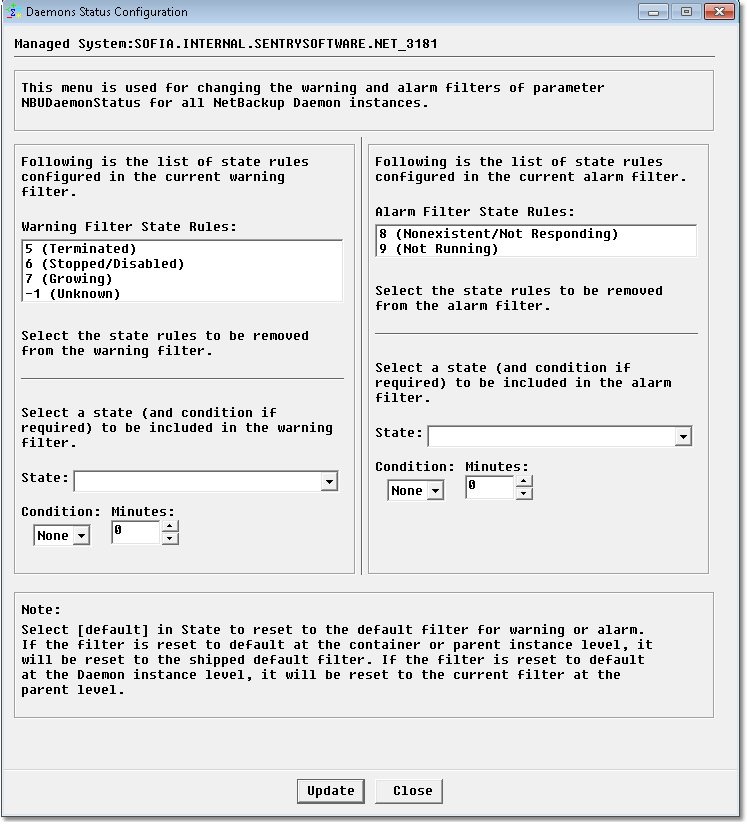
-
In the Warning Filter State Rules list, select the states that will not trigger a warning
-
If needed, apply a time condition to a specific state. For example, if you want to trigger a warning when the Growing state of the Daemon instance lasts more than 600 minutes:
- From the State list, select 7 (Growing)
- From the Condition list, select >
- In the Minutes field, enter 600
-
In the Alarm Filter State Rules list, select the states that will not trigger an alarm
-
If needed, apply a time condition to a specific state. For example, if you want to trigger an alarm when the Not Running state of the Daemon instance lasts more than 30 minutes:
- From the State list, select 9 (Not Running)
- From the Condition list, select >
- In the Minutes field, enter 30
-
Click Update. The mapping rule will be applied to that specific instance.
To revert to the default status mapping rule for either filter, select [default] from the list of states and click Update.
-
Resume the procedure for all the instances for which you wish to apply monitoring filters.
When a NetBackup client is not installed on the same network as the master server, the NBUClientStatus parameter can trigger a false alarm when the KM fails to ping the client. An additional script is available to avoid this situation. Use the following scripts when some NetBackup clients cannot be pinged from the master server:
On UNIX/Linux Master servers
cd $PATROL_HOME/lib/NBU
mv NBU_client_status.sh NBU_client_status_ping.sh
mv NBU_client_status_no_ping.sh NBU_client_status.sh
On Microsoft Windows Master servers
cd %PATROL_HOME%\lib${filePrefix}
ren NBU_client_status.cmd NBU_client_status_ping.cmd
ren NBU_client_status_no_ping.cmd NBU_client_status.cmd
Configuring Jobs Exit Status Filter
The NBUJobState parameter is set according to the completion state and the exit status reported by Veritas NetBackup. The parameter is set to:
- Completed if the job completes with exit status 0 (zero)
- Aborted if the exit status code is 150 (terminated by administrator)
- Error if the exit status is included in the Erroneous filter
- Failed if the exit status is included in the Failure filter
By default, all other exit status codes are set to Failed. This setting can be modified by moving or removing the keyword [ALL] in the Job Exit Status Filter.
To configure the exit status filter:
-
In the Console, right-click the Jobs instance > KM Commands > Configuration > Jobs Exit Status Filter…
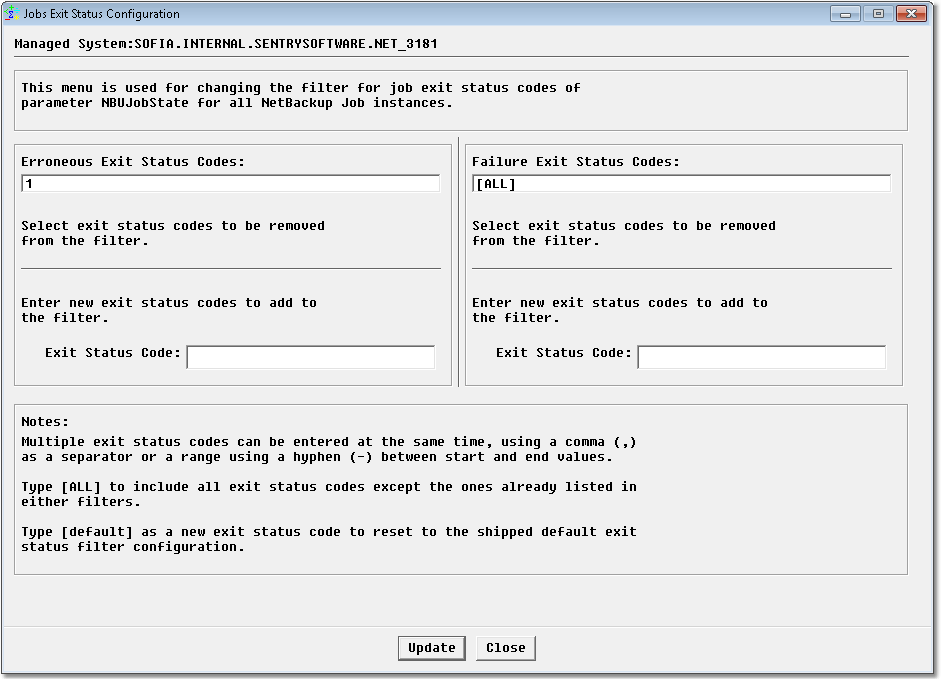
-
Select the exit status codes from the current filters which should be removed
-
Enter exit status code to be added to the erroneous or failure filter, which will set NBUJobState to Error or Failed respectively. Multiple comma (,) delimited codes or a range using a hyphen (-) can be entered at the same time
-
Click Update
-
Once all required changes are made, click Close to load the filters.
These filters will apply to all jobs from the next job collection cycle (NBUJobCollector).
Configuring Alert Acknowledgement
By default, alerts will automatically be acknowledged unless you modified the settings to allow manual acknowledgement.
Please note that manual acknowledgement may impact the performance of the application and of the PATROL Agent if the number of alerts waiting to be acknowledged constantly increases.
Configuring Jobs Alert Acknowledgement
By default, the alerts triggered on the NBUJobStatus parameter for the completed jobs are not acknowledged. If you want these alerts to be automatically acknowledged, you will have to configure the job alert acknowledgement as follows:
-
In the Console, right-click the Jobs instance > KM Commands > Configuration > Jobs Alert Acknowledgement…
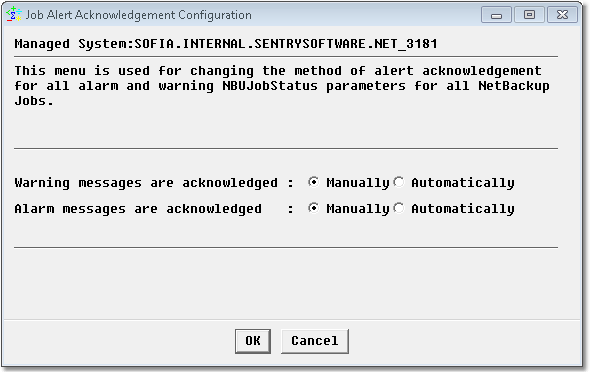
-
Indicate whether the warning and alarm messages will be manually or automatically acknowledged
-
Click OK.
Configuring Logs Alert Acknowledgement
By default, log alerts are automatically acknowledged when new ones are detected. To change the default behavior:
-
In the Console, right-click the Log(s) instance > KM Commands > Configuration > Log(s) Alert Acknowledgement…
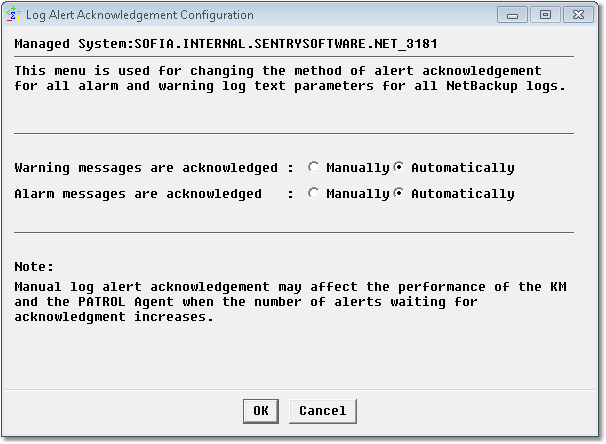
-
Indicate whether the warning and alarm messages will be manually or automatically acknowledged
-
Click OK.
Configuring the Discovery Overrides
The solution automatically discovers the installation, binary, and library paths. This information can however be overridden.
To configure paths:
-
In the Console, right-click the server instance > KM commands > Configuration > Paths…
-
In the KM section, verify and possibly modify the Home, Temp, and Debug Directory Paths
-
In the NetBackup section, verify and possibly modify the Installation, the Log, and the Remote Temp Directory (remote nodes only) Paths
-
In the Binary Paths and Library Paths sections:
- From the list, select the paths to be removed
- In the Path field, enter the new path(s) to be included. If several paths are to be entered, separate them with a colon (:).
-
Click OK.
If you want to rediscover the paths, empty all fields, click OK, and restart the PATROL Agent.
Configuring Logs
By default, the following log files are monitored. These log file paths are relative to the Veritas NetBackup log directory (for example /usr/openv/netbackup/db/error on UNIX and C:\Program Files\Veritas\NetBackup\db\error on Windows), unless the path is fully qualified as for the system logs.
| Log File | Description |
|---|---|
| On Solaris: | |
| daily_messages.log | Daily NetBackup Messages |
| /var/adm/messages | System Log |
| On HP-UX: | |
| daily_messages.log | Daily NetBackup Messages |
| /var/adm/syslog/syslog.log | System Log |
| On AIX/Linux: | |
| daily_messages.log | Daily NetBackup Messages |
| /var/log/messages | System Log |
| On Microsoft Windows: | |
| daily_messages.log | Daily NetBackup Messages |
| Events - Application/NetBackup | Windows Application Event Log |
Configuring the Log Filter
A log error filter can be configured to specify the regular expressions that will generate a warning or an alarm. Each time the KM finds these expressions in a log file (or in NBULogText), the error message will be written to the NBULogAlarmText or NBULogWarningText parameter. By default, the default log filter is configured for the daily Veritas NetBackup messages file and the system log file. If you enabled additional log files for monitoring, you will have to customize the log filter by adding appropriate expressions for those log files.
| Error Expression | Set to Parameter | Status |
|---|---|---|
| daemon.error | NBULogAlarmText | Included |
| exited | NBULogAlarmText | Included |
| skipping | NBULogAlarmText | Included |
| avrd | NBULogWarningText | Included |
| ltid | NBULogWarningText | Included |
| tld | NBULogWarningText | Included |
| vmd | NBULogWarningText | Included |
For more information about the possible error messages, refer to the Veritas NetBackup System Administrator’s Guide and the Veritas NetBackup Troubleshooting Guide.
To configure the log error filter:
-
In the Console, right-click the Logs instance > KM Commands > Configuration > Logs Filter…
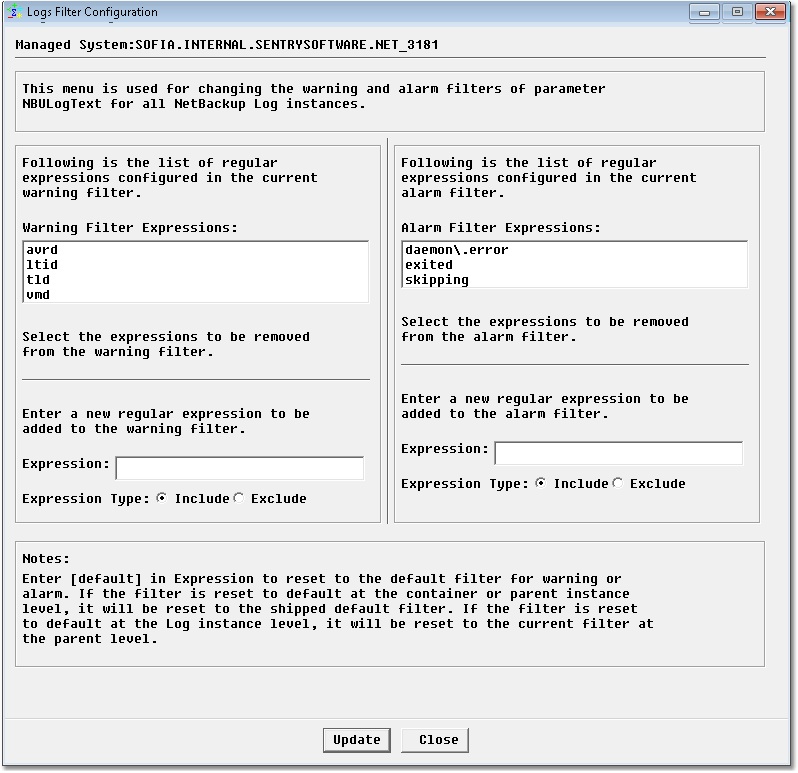
-
In the Warning Filter Expressions list, select the expressions that should be removed from the warning filter.
-
In the Alarm Filter Expressions list, select the expressions that should be removed from the alarm filter.
-
To add a new regular expression to the warning or alarm filter:
- In the Expression field, indicate the regular expression to be included (e.g.: skipping). Please note that regular expressions are case-sensitive.
- Select Include
-
To exclude a regular expression from the warning or alarm filter:
-
In the Expression field, indicate the regular expression to be excluded. You can also limit the exclusion to a particular expression already listed by using standard wildcard syntax.
-
Select Exclude
-
-
Click Update.
To revert to the default settings for either filter, type [default] as a new error expression for that filter, and click Update. If you revert to the default settings when accessed from the log instance level, the settings will revert to the parent or container instance level. To revert to the shipped default settings (as shown above), access this dialog from the log container instance. From this level you will also have the option to reset the configuration of any modified child instance.
Configuring the Log Scan Limit
The Veritas NetBackup KM scans log files by reading the new log entries since the last data collection cycle. By default, only 500 Kbytes of data is scanned for each log file during each data collection cycle. This log scan limit can however be modified to better suit your requirements.
To customize the log scan limit:
-
In the Console, right-click the Log(s) instance > KM Commands > Configuration > Log(s) Scan Limit…
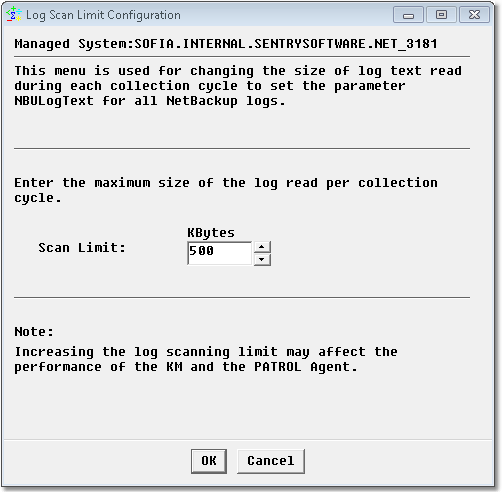
-
Indicate the amount of data that will be read by the KM during each data collection cycle.
-
Click OK.
Filtering Elements to Monitor
By default, the solution monitors all the discovered elements, except for Clients, Mount Requests, Standalone Drives and successful Jobs for which the monitoring can be manually enabled if required. To prevent excessive workload on agents and servers, and because the monitoring of some elements may be irrelevant for various reasons, you can also apply filters to indicate which elements will be monitored or not.
To filter elements to monitor:
-
In the Console, right-click one of the following instances depending on the elements that you wish to monitor:
- Clients > KM Commands > Configuration > Clients… to filter clients to be monitored
- Daemons > KM Commands > Configuration > Daemons… to filter daemons to be monitored
- Databases > KM Commands Configuration > Databases… to filter catalog databases to be monitored
- Logs > KM Commands > Configuration > Logs… to filter logs to be monitored.
- Media Servers > KM Commands > Configuration > Media Servers… to filter media servers to be monitored
- Policies > KM Commands > Configuration > Policies… to filter policies to be monitored. Please note that policy monitoring is disabled on the media servers and on the passive cluster nodes. If a policy is disabled, the jobs related to that policy will not be monitored.
- Policies > KM commands > Configuration > Policy Clients… to filter policy clients to be monitored
- Robotic Libraries > KM Commands > Configuration > Robotic Libraries… to filter robotic libraries to be monitored
- Robotic Drives > KM Commands > Configuration > Robotic Drives… to filter robotic drives to be monitored
- Standalone Drives > KM Commands > Configuration > Standalone Drives… to filter standalone drives to be monitored
- Volume Pools > KM Commands > Configuration > Volume Pools… to filter robotic volume pools to be monitored
- Storages > KM Commands > Configuration > Storages… to filter storages to be monitored
- Storages > KM Commands > Configuration > Disk Pools… to filter disk pools to be monitored
- Storages > KM Commands > Configuration > Disk Volumes… to filter disk volumes to be monitored
Note: These menus are also available from the child instances and will apply to all objects created under the child instances.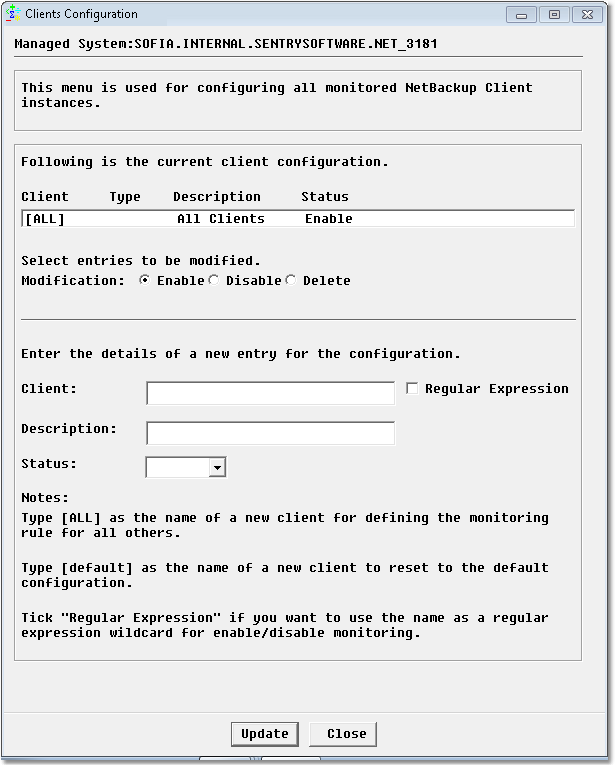
The
[ALL]entry ensures that all the elements found during PATROL discovery are instantiated and monitored. When installed on a Media Server, the default configuration monitors only the discovered local robotic libraries and local standalone drives. This is covered by the[LOCAL]entry in the default configuration on a Media Server. -
To enable elements for monitoring:
- In the current configuration list, select the elements to enable
- Select Enable
- Click Update
A log filter will have to be configured if you enable log files for monitoring.
-
To disable elements for monitoring:
- In the current configuration list, select the elements to disable
- Select Disable
- Click Update
All jobs associated to disabled policies are not monitored.
Disabled instances will be instantiated in an OFFLINE state. Commands will not be executed, thus leaving parameters not set.
-
To delete elements for monitoring:
- In the current configuration list, select the elements to delete
- Select Delete
- Click Update
-
To add a new element to monitor:
- Type the name of the element to be monitored (as it appears in the PATROL console) or a regular expression to be monitored
- If needed, enter a description
- From the Status list, select Enable
- Click Update.
To revert to the default monitoring configuration, type [default] as a new entry and click Update.
-
Resume the procedure for all the application classes for which you wish to apply monitoring filters.
Configuring the Jobs Monitoring
By default, Veritas NetBackup KM monitors failed and suspicious jobs for 1 day. The successfully completed jobs are not monitored. You can however modify these settings to better suit your requirements.
-
In the Console, right-click the Jobs instance > KM Commands > Configuration > Jobs…
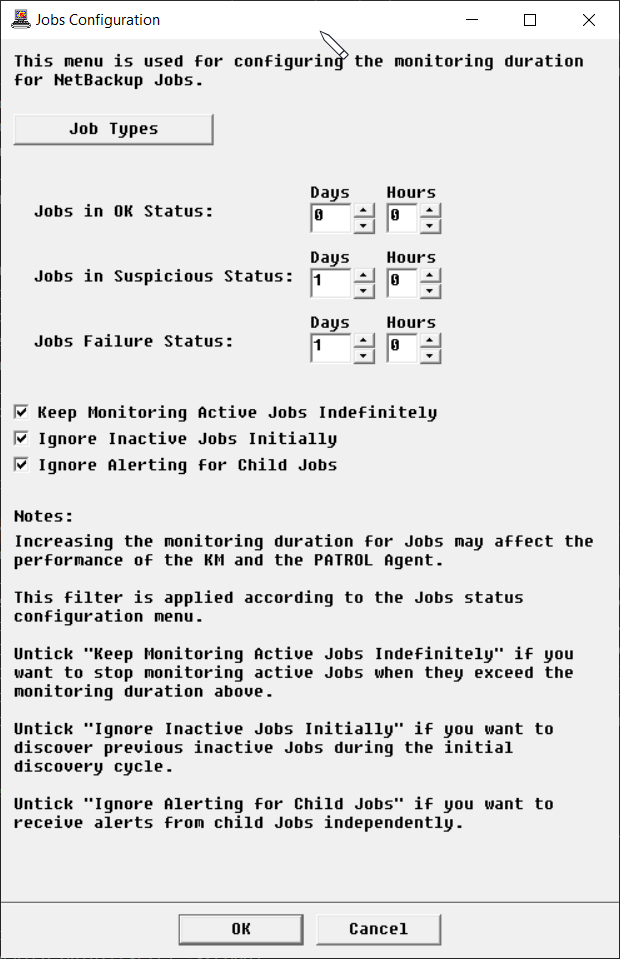
-
Click Job Types to indicate the job types to be monitored in a comma-separated list. These numbers can be found in the bpdbjobs command manual. Click Accept. Leave this field blank to reset to the default configuration.
-
Indicate how long the jobs in OK, Suspicious, and Failure status will be monitored. If you:
- decrease the monitoring period, older jobs will be destroyed on the next data collection cycle
- increase the monitoring period, you will have to force a full data collection to ensure all jobs are instantiated. To force data collection, right-click the Jobs instance > KM Commands > Force Full Collection
-
Select:
- Keep Monitoring Active Jobs Indefinitely if you want to endlessly monitor active jobs
- Ignore Inactive Jobs initially if you want the inactive jobs not to be created in the initial discovery cycle. Initially discovering and monitoring inactive jobs may impact the performance of the application
- Ignore Alerting for Child Jobs if you do not want to be notified when a job failure occurs on child jobs.
-
Click OK.
Configuring the Policy Backup Restriction Window
Veritas NetBackup KM can be configured to trigger an alert when a backup is started during a specific period of time:
-
In the Console, right-click:
- the Policies instance > KM Commands > Configuration > Policies Backup Restriction… to apply this customization to all policies
- a Policy instance > KM Commands > Configuration > Policy Backup Restriction… to apply this customization to a specific policy
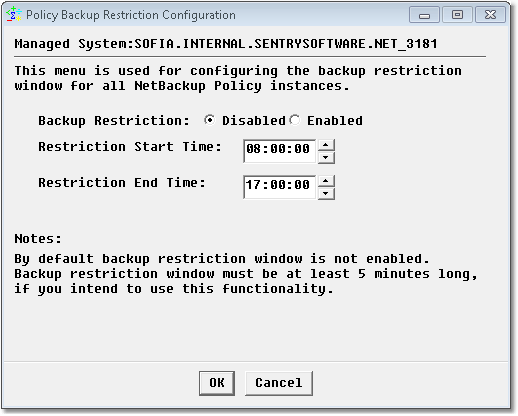
-
Select Enabled.
-
Indicate the Restriction Start and End Time. The restriction window should at least last 5 minutes.
-
Click OK.
Configuring the Mount Requests Monitoring
By default, Veritas NetBackup KM monitors mount requests for 1 day. You can however modify these settings to better suit your requirements.
-
In the Console, right-click the Mount Requests instance > KM Commands > Configuration > Mount Requests…
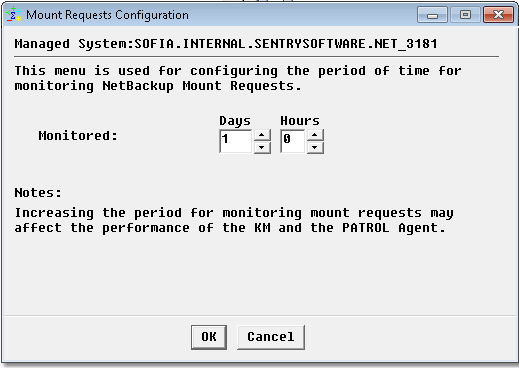
-
Indicate how long the mount requests will be monitored. If you decrease the monitoring period, older mount requests will be destroyed on the next data collection cycle
-
Click OK.
Configuring the Mount Requests Date/Time Format
The Veritas NetBackup KM uses Veritas NetBackup commands to determine the date and time of each mount request (used for calculating the elapsed time since the mount request was issued). Depending on your local system time zone and date/time format, the application may return a different date/time format.
To customize the mount request date/time format:
-
In the Console, right-click the Mount Requests instance > KM Commands > Configuration > Mount Requests Date/Time Format…
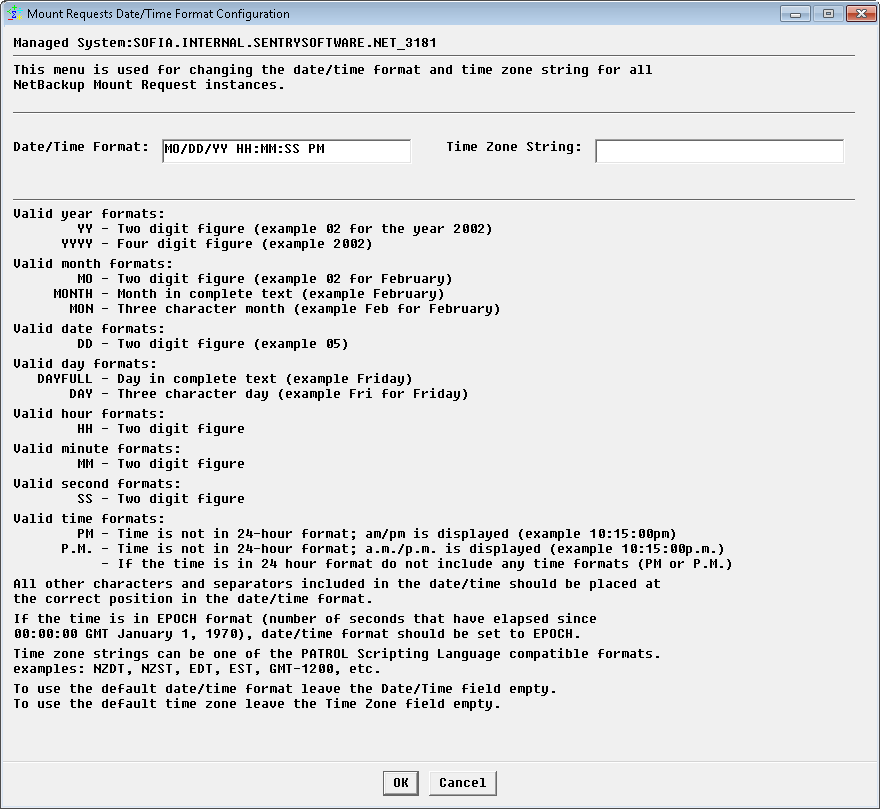
-
Indicate the expected Date/Time Format.
-
Indicate a PSL-compatible Time Zone String (e.g.: NZDT, NZST, EDT, EST, GMT-1200, etc.).
-
Click OK.
The new date/time format is then applied to all mount requests.
To revert to the default settings, blank out the Date/Time Format field and/or the Time Zone String field and click OK. The Time zone field used will be the local time zone on the managed node.
Configuring the Multi-Node Monitoring Mode
When Veritas NetBackup is installed in a cluster environment, i.e. active on one cluster node and passive on others, false alarms and duplicate alerts may occur. To avoid such situation, users need to configure Veritas NetBackup KM for PATROL in multi-node monitoring mode, if NetBackup is installed in a supported cluster.
To configure the multi-node monitoring mode:
-
In the Console, right-click the server instance > KM Commands > Configuration > Monitoring Mode…
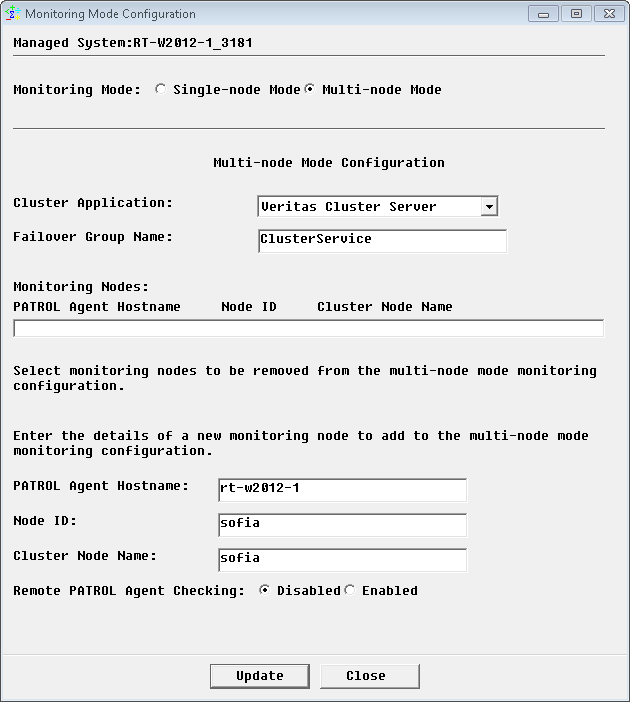
-
Select Multi-node Mode.
-
From the Cluster Application pull-down list, select an appropriate cluster application.
-
In the Failover Group Name field, enter the failover group name, which is online on one cluster node and offline on the others. Leave this field blank if you previously selected Veritas Cluster File System. The Veritas NetBackup KM will then monitor the entire cluster from the active master system, which is identified by the
vxdctl -c modecommand. This method requiresvxconfigdin enable mode with its clustered state active. -
Provide the details of all managed nodes of the cluster to be configured in the multi-node mode:
- PATROL Agent Hostname: host where the PATROL Agent is installed
- Node ID: the unique ID of the NetBackup node as configured in the KM menu Veritas NetBackup instance > KM Command > Configuration > NetBackup Nodes
- Cluster Node Name: the hostname defined in the selected Cluster Application.
-
Click Update.
-
Resume the procedure for all the other NetBackup nodes and click Update.
-
Check the Remote PATROL Agent Checking option if there are more than one PATROL Agent involved in the multi-node mode configuration above. If enabled, the KM queries the other PATROL Agents to check the monitoring status of other nodes.
-
Click Close.
-
If the Remote PATROL Agent Checking is Enabled, you will have to provide all the information required to communicate with the PATROL Agents (protocol, port number, credentials, attempts and timeout).
-
Click Close.
The NetBackup server will then be monitored through the master or online node in Active Multi-node Mode. The other nodes, which are standing by for a failover, will be in Passive Multi-node Mode, monitoring only the components that are not visible from the active node.
If a managed node is unable to check the monitoring status of the active managed node, it will change to Temporary Single-node Mode allowing full monitoring. It will remain in Temporary Single-node Mode until it finds the active node in full monitoring mode again.
If the Remote PATROL Agent Checking is Disabled, while there are more than one PATROL Agent involved, the managed node on the master or online node will be in Active Multi-node Mode and all others will be in Passive Multi-node Mode, without checking the monitoring status of the active node. In addition, the above procedure to configure Multi-node Mode (server instance > KM Commands > Configuration > Monitoring Mode) needs to be repeated from each PATROL Agent involved.
Configuring the Node Status
Veritas NetBackup KM allows you to choose which daemons will be used to determine the node status:
-
In the Console, right-click the Server instance> KM Commands > Configuration > Node Status…
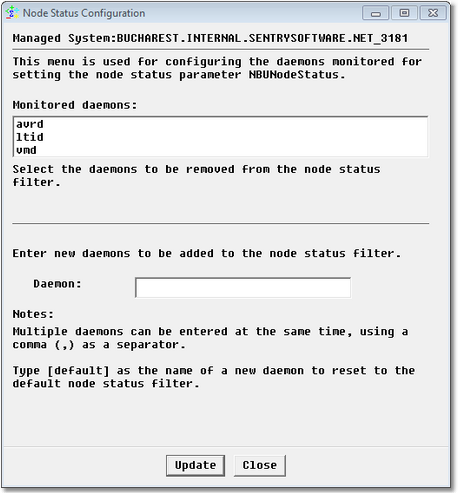
-
In the Monitored daemons list, select the daemons that will not be used to determine the node status
-
In the Daemon field, list the daemons to be used to determine the node status. The Daemon list must be comma-delimited.
-
To use default settings, type
[default]in the Daemon field -
Click Update.
The NBUNodeStatus parameter will then be set to:
- Suspicious if any command run by the Veritas NetBackup KM returns a server error message
- Failure if any configured daemon is not running.
Configuring the Node Type
You may have to manually indicate the type of node monitored if the discovery fails to recognize it:
-
In the Console, right-click the server instance > KM Commands > Configuration > Node Type…
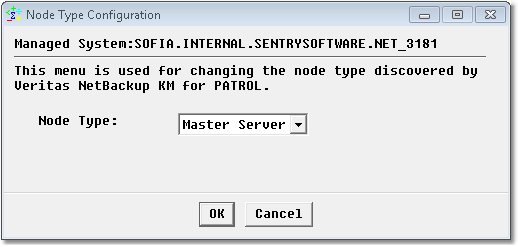
-
Select the node type (Master Server or Media Server)
-
Click OK.